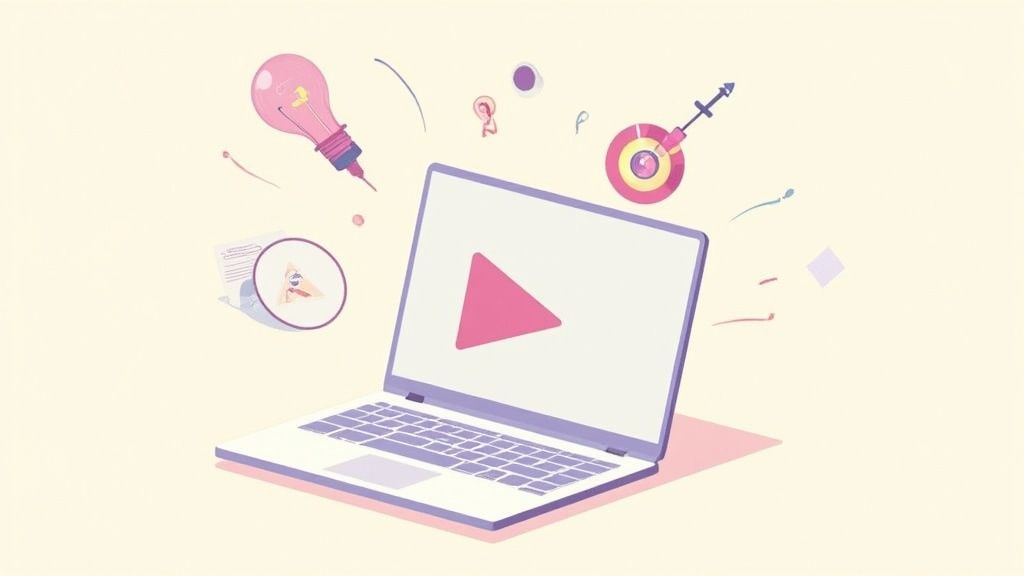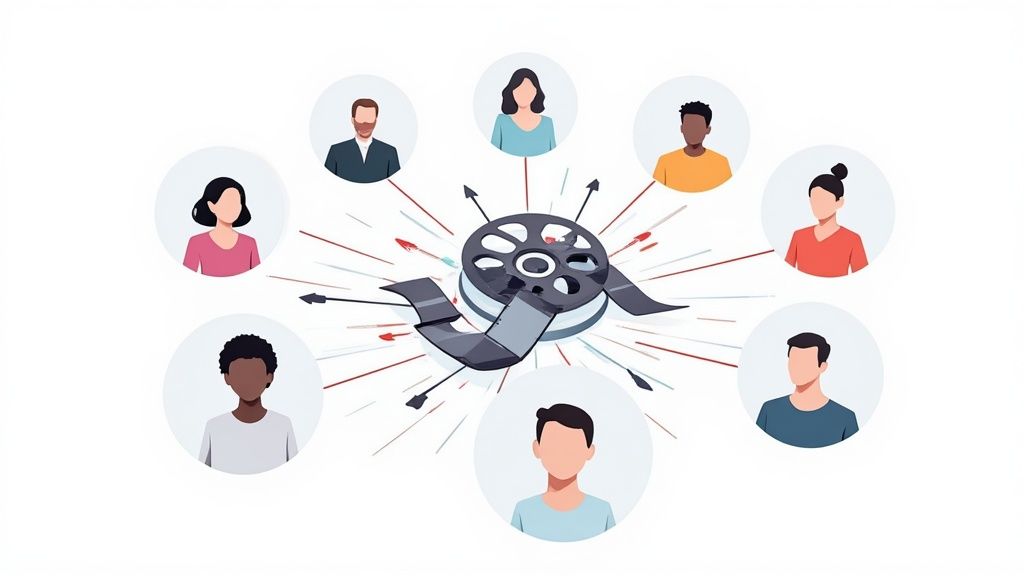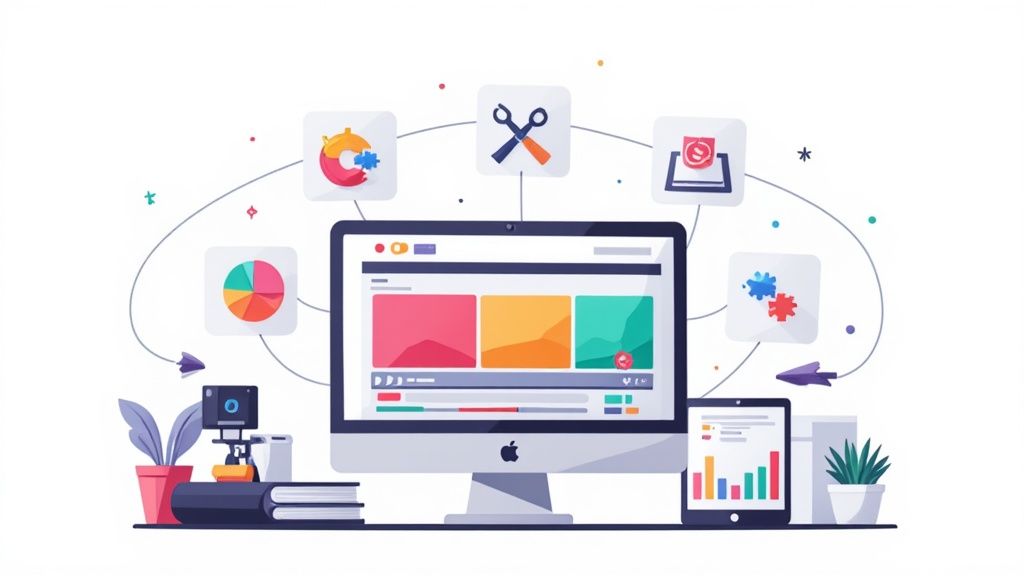How to Create Video Hooks That Stop Scrolling in Seconds – Easy Tips


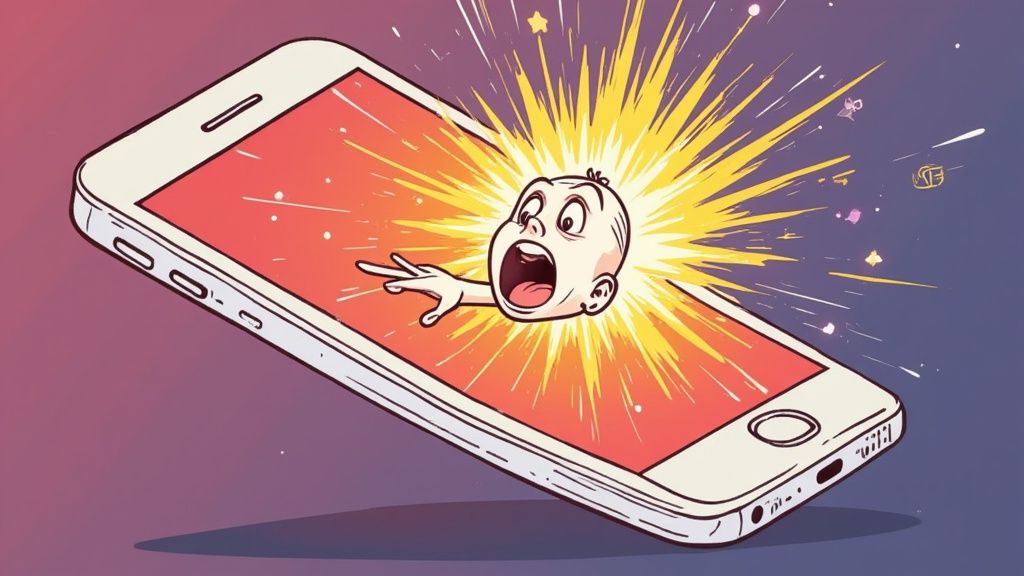
Crafting a killer video hook isn't a game of chance. It’s a science, really. You have to master the art of delivering instant value. The secret? Focus on three key things in those first few seconds: spark curiosity, show clear value, and trigger an emotion. Nail these, and you'll have a hook that stops the scroll dead in its tracks.
Why the First Three Seconds Define Your Video's Success
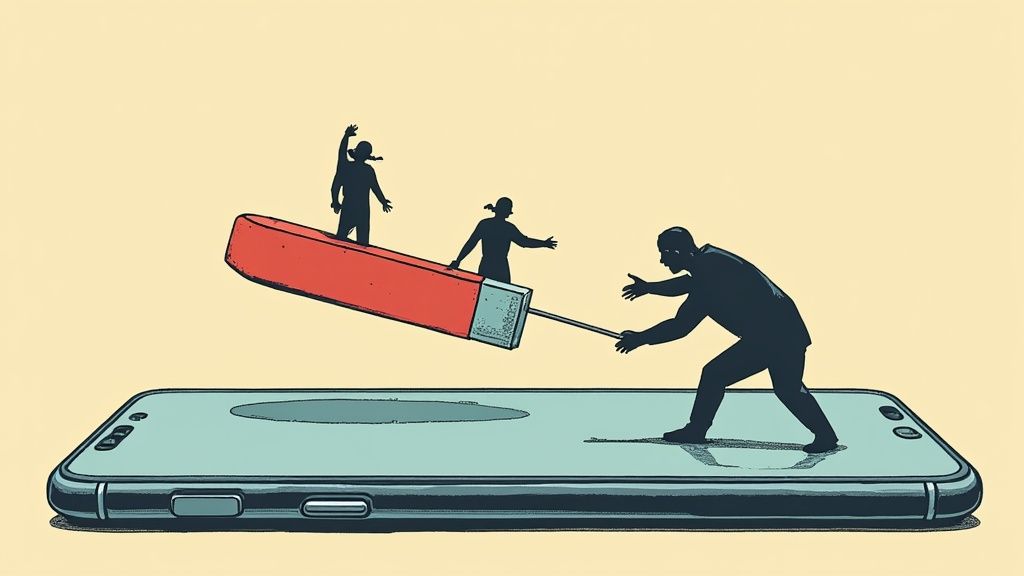
Let's be real—we're all guilty of the endless, mindless scroll. Our thumbs just keep flicking, making snap judgments on dozens of videos in milliseconds. This isn't just a bad habit; it's the reality of how we consume media today. In this ridiculously crowded space, the first three seconds of your video are everything.
Your audience doesn't owe you their attention. They're actively looking for a reason to swipe away, and a weak opening is the number one excuse they need. A powerful hook isn't just some clever gimmick; it’s a strategic move to cut through viewer apathy and scream, "Hey, this is worth your time!"
Your hook is the gatekeeper to the rest of your video. If it fails, even the most brilliant content will never be seen. It's the single most critical element for success in video marketing today.
To give you a better idea of what goes into a scroll-stopping hook, I’ve broken it down into three core pillars. Mastering these components is essential for capturing your audience's attention right from the start.
The Three Pillars of an Effective Video Hook
By weaving these elements into your opening, you create a powerful magnetic pull that makes it almost impossible for your target viewer to scroll past.
The Psychology of the Scroll
The choice to watch or swipe is almost entirely subconscious. Viewers are blitzing through content, rapidly scanning for signals that answer a few key questions:
- Is this for me? The video has to feel immediately relevant to their problems, interests, or identity.
- What’s in it for me? There must be a clear promise of value, whether it's a solution, a laugh, or a new insight.
- Is this going to be boring? The hook needs to signal that the video is dynamic and won't be a waste of their precious time.
If your opening doesn't hit these points in about three seconds, you've lost them. This reality is only amplified by the sheer volume of content out there. The explosion of short-form video has completely rewired what audiences expect. People now demand quick, digestible content that gets straight to the point. You can learn more about the strategy behind this in our complete guide to video marketing production.
The Shift to Snackable Content
The modern viewer's love for brevity is undeniable. We've gone from long-form articles and lengthy tutorials to bite-sized clips designed for quick hits of information or entertainment. This is a direct result of our shrinking attention spans and a mobile-first world where we consume media in short bursts—waiting for coffee, on the bus, or during a quick break.
Short-form video is on track to become the main way people engage with content by 2025, which just hammers home how vital a killer hook is. With around 90% of consumers watching short videos on their phones every single day, platforms like TikTok and Instagram Reels have made sub-60-second content the new normal.
Knowing how to create video hooks that stop people from scrolling isn't just a nice-to-have skill anymore. It's a survival tactic for anyone trying to get noticed online.
A great hook acts as an instant filter. It grabs the right people and lets the wrong ones keep on scrolling. It’s your first and best shot to prove your video is worth their time, which ultimately drives every metric that matters—from watch time and engagement to actual conversions.
Tapping Into Human Psychology to Make Viewers Stop and Stare
To create a video hook that actually stops the scroll, you need to put on your psychologist hat for a minute. Forget flashy effects or clickbait for a second. The real secret lies in understanding the basic triggers that make our brains snap to attention.
When you get why something works, you can build a repeatable process. It’s about moving beyond surface-level tips and digging into the psychological drivers that make some hooks feel absolutely magnetic. These aren't tricks; they're proven principles of human behavior that the best creators use, sometimes without even realizing it.
Spark an Unquenchable Curiosity
One of the most potent tools in your playbook is the Curiosity Gap. Think of it as a mental itch that appears when there’s a gap between what we know and what we want to know. A killer hook opens this gap and promises to close it, making viewers feel an almost irresistible urge to watch.
You can create this gap by:
- Asking a direct, intriguing question: "Why is your 'healthy' breakfast actually making you tired?"
- Making a bold, counterintuitive statement: "You've been folding your shirts all wrong your entire life."
- Teasing a secret or an uncommon solution: "The one thing top performers do every morning that you don't."
Each of these makes the viewer's brain ask a question it now desperately needs an answer to. The only way to scratch that mental itch? Keep watching. The trick is to make the promise specific enough to be believable but intriguing enough to build that suspense.
The Pull of Loss Aversion
Here’s a fun fact about our brains: we’re often more motivated by the fear of losing something than by the idea of gaining something of equal value. This is called Loss Aversion, and you can use it to frame problems in a way that demands an immediate solution.
Instead of highlighting what someone could gain, your hook can focus on what they stand to lose if they don't watch. It’s a subtle but powerful shift that taps into our primal instinct to avoid threats and solve problems that could hurt us.
A hook like, "Here's how to gain 5 more hours a week," is interesting. But a hook that says, "This one productivity mistake is costing you 5 hours a week," is urgent. It frames the problem as an active threat that needs to be fixed now.
This approach works because it connects your video directly to a pain point your audience is already feeling. It feels less like an ad and more like a lifeline. These principles are especially powerful in visual formats, which is why having a good grasp of how to create effective animated business videos can give you another fantastic tool for telling these kinds of stories.
Use Social Proof for Instant Authority
Another powerful trigger is Social Proof—the idea that we naturally trust things more when we see that other people do, too. You can build this trust in the first few seconds of your video by dropping a compelling stat or a surprising piece of data. When viewers see hard numbers, they instantly perceive your content as more authoritative and well-researched.
For example, a hook like, "Over 80% of businesses fail because of this one simple cash flow error," immediately establishes credibility. It tells the viewer this isn't just your opinion; it's a fact-based insight that affects a lot of people, making it feel much more relevant.
This is especially effective for short-form video, where viewers make split-second judgments about a creator's expertise. In fact, data shows that roughly 30% of short-form videos achieve an average watch rate of over 81%. That proves that when a hook lands, viewer retention is incredibly high. And with 73% of consumers preferring short-form video to learn about products, a hook that quickly establishes relevance can directly influence buying decisions.
When you start combining these psychological principles—the pull of curiosity, the push of loss aversion, and the trust from social proof—you move beyond just guessing. You start creating hooks based on a real understanding of what makes people tick, giving your videos the best possible shot at capturing an audience and keeping them glued to the screen.
The Unbeatable Formula for Writing and Designing Hooks
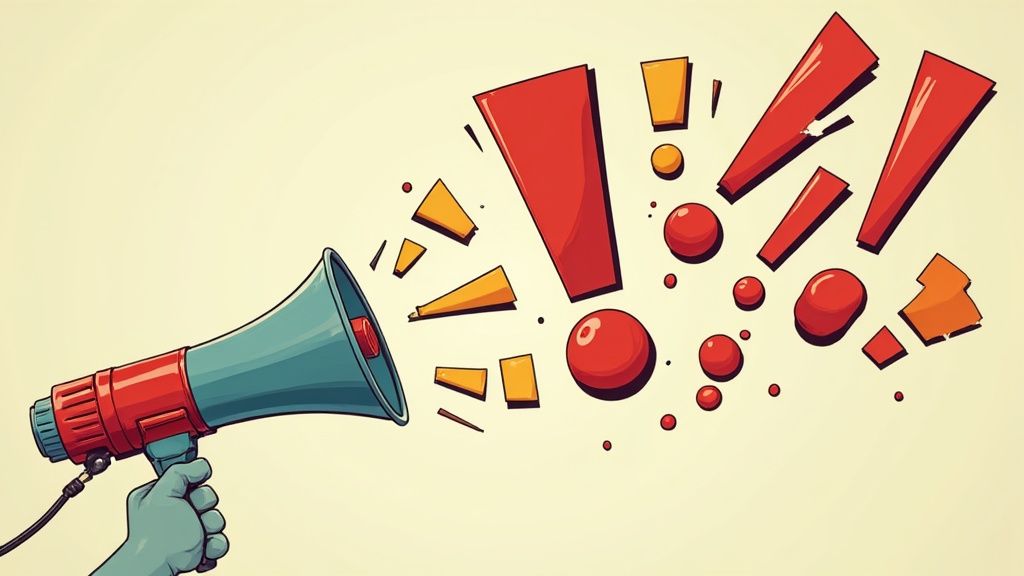
Alright, we’ve covered the psychology. Now it’s time to put that theory into practice.
Crafting a killer hook is where science meets art. It’s a delicate dance between a magnetic script and intentional visual design. Forget the vague advice you've heard before; let's get into the nitty-gritty with proven formulas you can immediately steal and adapt, whether you're in e-commerce or B2B tech.
A powerful hook is so much more than the words you say. Think of it as a one-two punch: your script and your visuals have to work together in that critical first moment. When they’re in sync, they create an opening that’s almost impossible to scroll past.
Proven Formulas for Writing Hooks
Why reinvent the wheel? Certain hook structures just work because they tap directly into the psychological triggers we talked about. I always recommend starting with these battle-tested formulas and then tweaking them to fit your specific audience and message.
The Problem-Agitate-Solution (PAS) IntroThis is a classic for a reason. It’s a copywriting powerhouse that translates perfectly to video. You pinpoint a problem your viewer has, twist the knife by describing the frustration it causes, and then dangle the solution right in front of them.
- Problem: "Tired of spending hours editing a 30-second video?"
- Agitate: "It’s a massive time suck that crushes your creative flow and keeps you from posting consistently."
- Solution: "Here’s how I edit my videos in under 10 minutes using just my phone."
The Controversial Statement OpenerNothing jolts a viewer out of their mindless scrolling like a bold statement that goes against the grain. It instantly disrupts their expectations and makes them lean in, wanting to know why you’d say such a thing. Just be sure you can back it up.
- E-commerce Example: "That viral skincare product everyone loves? It’s actually wrecking your skin barrier."
- B2B Tech Example: "Your expensive project management software is the real reason your team is blowing past deadlines."
The Direct Question HookAsking a direct question is like tapping your viewer on the shoulder. It forces them to mentally engage and become an active participant from the get-go. The more specific the question is to their pain points, the better.
- General Example: "Are you making one of these three common money mistakes?"
- Targeted Example: "Does your SaaS company struggle with a scary-high customer churn rate?"
The goal isn’t to find one single, magical hook. It’s to build a whole library of them. Once you have a collection of formulas that work, you can test different ones across topics and platforms to see what your audience responds to most.
To really get the creative juices flowing, I'd suggest digging into resources like this collection of 100 Viral Hooks for Content Marketing. Seeing a ton of real-world examples can spark ideas you never would have thought of on your own.
Designing the Visual Side of Your Hook
Your script is only half the battle. What your viewer sees in those first 3 seconds is just as crucial, especially for the huge chunk of people watching with the sound off. A static, boring opening is a death sentence for your video’s engagement.
You have to pair that killer script with an equally compelling visual. Here’s how to design a hook that stops the scroll.
Start with Immediate and Intriguing MotionA static shot is an invitation to keep scrolling. Your video needs to have something happening on screen right away. This doesn't mean you need a Hollywood-level explosion, but some kind of movement is non-negotiable.
- Simple Motion: A quick camera zoom-in, someone walking into the frame, or even a fast pan can signal that this isn't just another boring video.
- Product Motion: If you're showing a product, don't let it just sit there. Drop it, spin it, or unbox it with some energy. That initial motion is a visual cue that something interesting is happening here.
Use Dynamic Text OverlaysOn-screen text is your secret weapon. It guarantees your hook lands even if the audio is off and reinforces your point for those who are listening.
Craft a Compelling Opening FrameThe very first frame—which often doubles as your video's thumbnail—needs to be interesting all on its own. It should create curiosity and give a hint of what's to come. A blurry, bland, or boring opening frame will get you scrolled past before your video even has a chance to play. Think of it as your book cover; it has to be enticing.
Learning to master this blend of script and screen is vital for all types of content, but it's especially important for more complex topics where you need clarity. If you're explaining a product or service, for example, our guide on how to make an explainer video dives deeper into structuring these visual stories for maximum impact. When you nail both what you say and what you show, you create an unbeatable formula for hooks that truly stop the scroll.
Tailoring Your Hooks for Every Social Platform
A hook that blows up on TikTok can fall completely flat on LinkedIn. Why? It's not because the hook is bad. It's because the audience's mindset and the platform's culture are worlds apart. If you treat every social channel the same, you're just wasting creative energy.
The real secret to making video hooks that actually stop the scroll is to match your approach to each unique environment.
To really nail your hooks, you first need a solid grasp of mastering social media platforms and their quirks. The context a person is in when they see your video—whether they're killing time or looking for career advice—completely changes what will catch their eye. A universal strategy just won't cut it.
TikTok: Fast-Paced and Trend-Driven
TikTok is all about speed, trends, and raw authenticity. People on this platform have zero patience for anything that feels too polished or moves too slowly. Your hook needs to fit right into this fast-paced, sometimes chaotic, world.
Success on TikTok often means jumping on a trending audio or sound almost as soon as it starts gaining steam. The sound itself is a huge part of the hook, signaling to users that you're in on the culture.
- Actionable Tip: Jump on a trend immediately, but put your own unique spin on it. For instance, use a popular sound but pair it with a totally unexpected visual from your industry.
- Hook Example: Don't bother with a formal intro. Start with the trending audio playing and a bold text overlay like, "This marketing hack is not what you think."
Instagram Reels: Aesthetic and Aspirational
While Instagram Reels feels similar to TikTok, it often leans more toward polished aesthetics, aspirational content, and slick storytelling. Users here appreciate a beautiful visual, a clean look, and content that’s either inspirational or valuable in a visually pleasing package.
Your hook needs to lead with an eye-catching visual from the very first frame. Think cinematic B-roll, satisfying transitions, or a shot that's so high-quality people pause just to admire it.
On Instagram, the most powerful hooks blend stunning visuals with a promise of value. A beautiful opening shot paired with a curiosity-sparking text overlay is a combo that feels right at home on the platform.
If you need some inspiration for what works visually, checking out these Instagram video ads examples is a great way to see how you can craft a hook that's both beautiful and effective.
YouTube Shorts: Educational and Search-Focused
YouTube Shorts caters to a pretty unique audience. While entertainment is part of the equation, many users show up with the intent to learn something specific. They’re often in a "how-to" headspace, searching for quick answers and direct value.
Your hook should act like a direct answer to a question they might be searching for. Get straight to the point and frame your opening around a clear learning outcome.
- Hook Style: Try a question-and-answer format or a direct "Here's how to do X" statement.
- Example Hook: "Here's the fastest way to unblur a photo using just your phone." It's direct, it promises a solution, and it taps right into the search-driven nature of the YouTube audience.
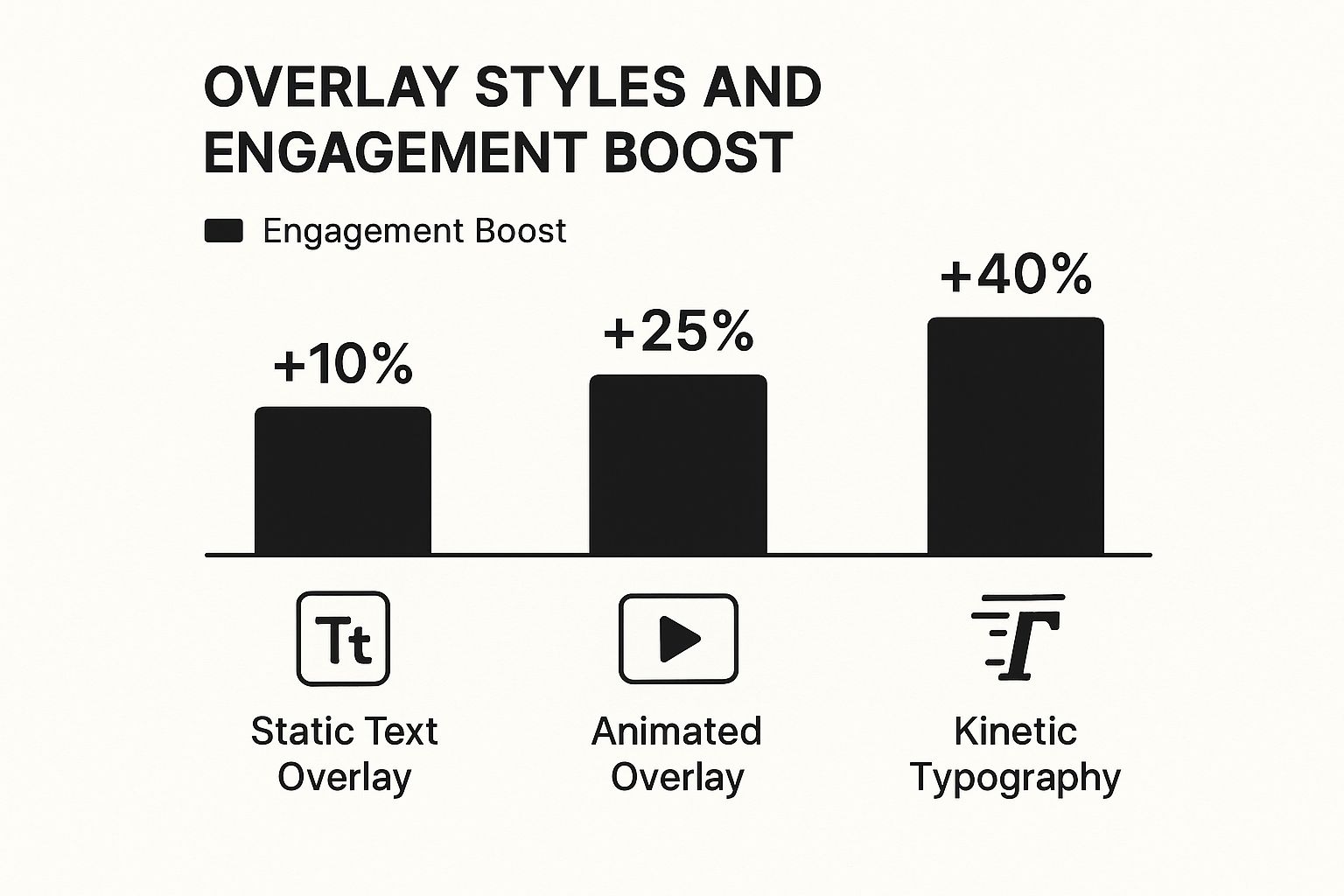
This image really drives home how much on-screen text matters, no matter the platform. The data shows that kinetic typography—text that moves and animates—can deliver an incredible 40% boost in engagement. That's a huge advantage over static text.
LinkedIn: Professional Problem-Solving
Think of LinkedIn as the corporate headquarters of social media. The user mindset here is all about professional growth, industry news, and career development. A hook that feels like a casual TikTok dance will stick out for all the wrong reasons.
Here, your hook needs to be framed around a professional challenge or a valuable business insight. Speak the language of your industry, address a common pain point, or offer up a strategic tip.
Platform-Specific Hook Strategies at a Glance
Every platform has its own rhythm and user expectations. A hook that's a hit on one can be a miss on another. This table gives you a quick rundown of how to think about your opening seconds on the major players.
Ultimately, tailoring your hook is really an exercise in empathy. When you understand what your audience is looking for in that specific moment on that specific platform, you can craft an opening that feels less like an interruption and more like an essential piece of content they were hoping to find.
Designing Hooks That Work Even with the Sound Off
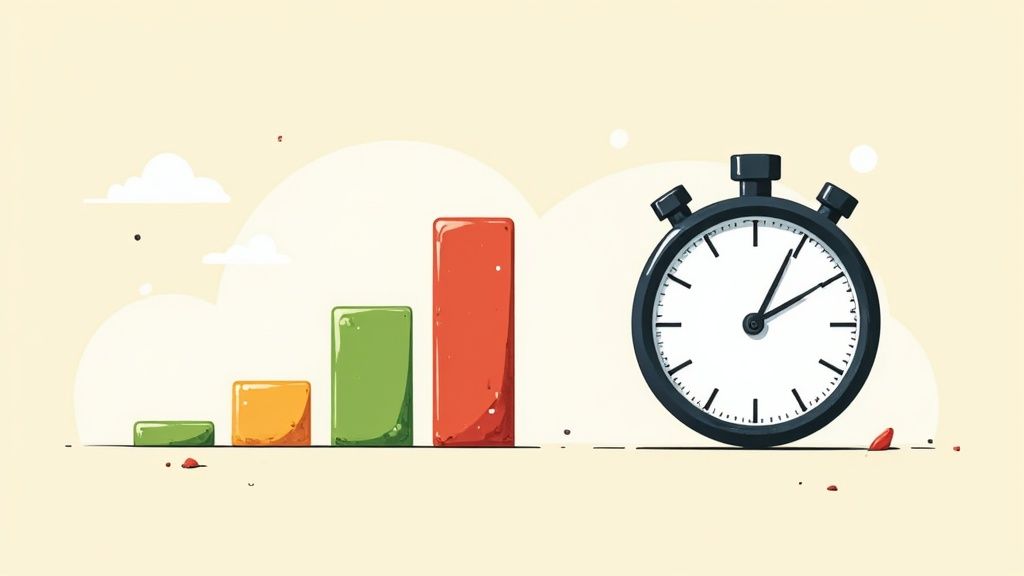
Let's get real for a second: most people are silent scrollers. Think about it. Whether they're on a quiet commute, in a waiting room, or just winding down on the couch next to a sleeping partner, the majority of your audience will see your video with the sound off first.
If your brilliant hook depends entirely on a clever line of dialogue or a trending audio clip, you’ve already lost a massive chunk of your audience. It's time to start thinking like a silent film director. Your goal is to stop the scroll using visuals alone. This means every single element—from your text overlays to your on-screen actions—has to work overtime to grab attention and get your point across instantly.
The Power of On-Screen Text
Dynamic, on-screen text is your number one weapon for sound-off success. I'm not just talking about basic subtitles; these need to be a core part of the creative itself. Think of them as a visual anchor that immediately communicates the value of your video and holds the viewer's attention.
When done right, text overlays do more than just repeat what you're saying. They add emphasis, create a visual rhythm, and make your content way more skimmable. A viewer should understand the entire premise of your video without ever having to unmute it.
Accessibility is a huge factor here, too. Captioning usage has shot up by an incredible 572% since 2021. This stat alone proves how critical it is for videos to be understood without sound. Making your content accessible doesn't just feel good; it directly improves watch time and retention, helping your hooks land with everyone. You can find more insights on this trend in these video advertising statistics on blog.keitaro.io.
To make your on-screen text as effective as possible, here are a few tips from my own experience:
- Keep it Bold and Simple: Stick with a clean, sans-serif font that’s easy to read on a tiny screen. Make sure there’s high contrast between your text and the background. White text with a black outline or drop shadow is a classic for a reason.
- Animate Key Words: Don’t just let the text sit there. Make important words pop, slide in, or change color to draw the eye and add a jolt of energy. This simple trick prevents the visual experience from feeling flat.
- Pace the Text: This is a big one. Avoid dumping a huge block of text on the screen at once. Reveal your captions phrase by phrase, timed to your speaking pace. This technique, often called kinetic typography, guides the viewer’s attention and makes the whole video feel much more dynamic and professional.
Turn Passive Viewers into Active Participants
Beyond just text, another killer way to hook a silent viewer is to build interactive elements right into the first few seconds. This strategy is all about shifting someone from being a passive observer to an active participant, which massively increases their investment in what you have to say.
Polls and quizzes are gold for this. They pose a direct question that forces an immediate mental—or even physical—response. That simple moment of engagement can be the difference between a swipe and a full watch.
Let's look at a real-world scenario: A FinTech App
- Weak Hook (Audio-Reliant): A video starts with an expert saying, "Are you saving enough for retirement? Most people aren't." To a silent viewer, this is just a talking head. They'll scroll right past.
- Strong Hook (Visual & Interactive): The video opens with a clean graphic and a poll sticker slapped right on top. The question reads, "How much have you saved for retirement?" with options like "$0-$10k," "$10k-$50k," and "$50k+." This immediately grabs the viewer, makes them think about their own situation, and makes the video's topic instantly relevant.
What you're doing here is creating a micro-commitment. Once a viewer has engaged, even in this small way, they're psychologically wired to stick around to see the results or learn the answer. It’s a simple but powerful trick that builds immediate rapport and turns your hook from a flat statement into a personal experience.
Common Questions About Creating Video Hooks
Even with a solid strategy, you're bound to have questions when you start putting these ideas into practice. Let’s tackle some of the most common sticking points creators face when trying to master the art of the scroll-stopping hook.
Getting these details right can make all the difference.
How Long Should a Video Hook Actually Be?
Your hook's entire mission has to be accomplished in the first 1-3 seconds. That's it. The goal is to stop the scroll instantly, leaving no room for a viewer to second-guess and swipe away.
Think of it as a quick, one-two punch. The first second uses a sharp visual or a bold on-screen statement to physically stop their thumb. The next two seconds must then cement that interest by either opening a curiosity gap or promising immediate, clear value.
A hook isn't a long, rambling intro. It's a short, sharp burst of energy designed to achieve one thing: earn you the next five seconds of their attention.
Can I Just Use the Same Hook for All My Videos?
While developing a signature style is great for branding, using the exact same hook over and over is a recipe for "hook fatigue." Your most loyal followers will quickly learn to tune it out because they know exactly what's coming. Predictability is the enemy of a great hook.
Instead, your goal should be to build a library of proven hook formulas that feel authentic to your brand.
Expert Tip: Don't just recycle one hook. Build a go-to list of 3-5 different hook styles—like a question hook, a controversial statement, and a problem-focused hook. Rotate through them based on the video's topic and platform to keep your content feeling fresh and unpredictable.
This approach gives you brand consistency without becoming boring. A question hook might be perfect for educational content, while a surprising visual hook could work wonders for a product reveal or a more entertaining video. Versatility is the key to long-term engagement.
How Do I Know If My Hook Is Working?
The data never lies. Your most critical metric here is the Audience Retention graph, which is easy to find in your TikTok, Instagram, and YouTube analytics.
A strong hook is immediately obvious on this graph. You'll see a very high percentage of viewers still watching after the 3-to-5-second mark, with the line staying relatively flat before it starts to gradually decline.
On the flip side, a steep, immediate drop-off is a clear signal your hook failed to connect. It means viewers swiped away almost instantly.
You can also A/B test different hooks for the same core video by posting variations and comparing the retention data head-to-head. This is the fastest way to learn what truly resonates with your audience. For more ideas on how to structure these types of videos, check out our guide on creating engaging FAQ videos.
Stop wondering if your video content is working and start seeing real results. At Moonb, we provide on-demand access to a full creative team—from strategists to animators—to craft scroll-stopping videos that drive growth. Get consistent, high-quality creative assets with a fixed monthly fee.



